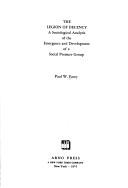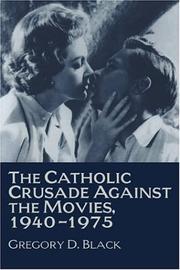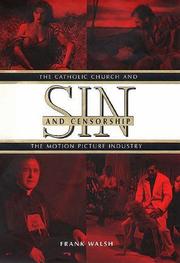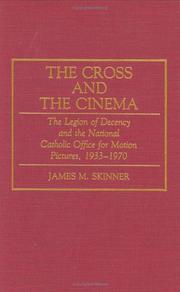| Listing 1 - 8 of 8 |
Sort by
|

ISBN: 0405048718 Year: 1974 Publisher: New York (N.Y.): Arno Press
Abstract | Keywords | Export | Availability | Bookmark
 Loading...
Loading...Choose an application
- Reference Manager
- EndNote
- RefWorks (Direct export to RefWorks)
Motion pictures --- Motion pictures --- Censorship --- Moral and ethical aspects --- National Legion of Decency.

ISBN: 0521594189 0521629055 Year: 1998 Publisher: Cambridge : Cambridge university press,
Abstract | Keywords | Export | Availability | Bookmark
 Loading...
Loading...Choose an application
- Reference Manager
- EndNote
- RefWorks (Direct export to RefWorks)
Motion pictures --- Cinéma --- Censorship --- Moral and ethical aspects. --- Censure --- Aspect moral --- National Legion of Decency. --- Cinéma

ISBN: 0521565928 Year: 1994 Publisher: Cambridge [England],New York, NY : Cambridge University Press,
Abstract | Keywords | Export | Availability | Bookmark
 Loading...
Loading...Choose an application
- Reference Manager
- EndNote
- RefWorks (Direct export to RefWorks)
Motion pictures --- Motion pictures --- Cinéma --- Cinéma --- Censorship --- Moral and ethical aspects --- Censure --- Aspect moral --- National Legion of Decency

ISBN: 0300063733 9780300063738 Publisher: New Haven, Conn. Yale University Press
Abstract | Keywords | Export | Availability | Bookmark
 Loading...
Loading...Choose an application
- Reference Manager
- EndNote
- RefWorks (Direct export to RefWorks)
During World War I, the Catholic church blocked the distribution of government-sponsored VD-prevention films, initiating an era of attempts by the church to censor the movie industry. This book is an entertaining and engrossing account of those efforts - how they evolved, what effect they had on the movie industry, and why they were eventually abandoned. Frank Walsh tells how the church's influence in Hollywood grew through the 1920s and reached its peak during the 1930s, when the film industry allowed Catholics to dictate the Production Code, which became the industry's self-censorship system, and the Legion of Decency was established by the church to blacklist any films it considered offensive. With the industry's Joe Breen, a Catholic layman, cutting movie scenes during production and the Legion of Decency threatening to ban movies after release, the Catholic church played a major role in determining what Americans saw and didn't see on the screen during Hollywood's Golden Age. However, notes Walsh, there were serious divisions within the church over film policy. Bishops feuded with one another over how best to deal with movie moguls, priests differed over whether attending a condemned film constituted a serious sin, and Legion of Decency reviewers disagreed over film evaluations. Walsh shows how the decline of the studio system, the rise of a new generation of better-educated Catholics, and changing social values gradually eroded the Legion's power, forcing the church eventually to terminate its efforts to control the type of film that Hollywood turned out. In an epilogue he relates this history of censorship to current efforts by Christian fundamentalists to end "sex, violence, filth, and profanity" in the media.
Motion pictures --- Censorship --- Moral and ethical aspects. --- censuur --- film --- General ethics --- Film --- National Legion of Decency --- Moral and ethical aspects --- United States --- #SBIB:309H1314 --- #SBIB:316.331H537 --- #SBIB:316.331H340 --- Cinema --- Feature films --- Films --- Movies --- Moving-pictures --- Audio-visual materials --- Mass media --- Performing arts --- Filmwezen: politieke, juridische, ethische, ideologische aspecten --- Godsdienstige praktijken: massamedia --- Godsdienst en cultuur: algemeen --- History and criticism --- National Legion of Decency. --- Catholic Church. --- Legion of Decency --- National Catholic Office for Motion Pictures (U.S.)
Book
ISBN: 0521452996 Year: 1994 Volume: *2 Publisher: Cambridge [England] New York, NY, USA Cambridge University Press
Abstract | Keywords | Export | Availability | Bookmark
 Loading...
Loading...Choose an application
- Reference Manager
- EndNote
- RefWorks (Direct export to RefWorks)
791.43 --- #SBIB:309H1314 --- Motion pictures --- -Motion pictures --- -Cinema --- Feature films --- Films --- Movies --- Moving-pictures --- Audio-visual materials --- Mass media --- Performing arts --- Filmkunst. Films. Cinema --- Filmwezen: politieke, juridische, ethische, ideologische aspecten --- Censorship --- -Moral and ethical aspects --- History and criticism --- National Legion of Decency --- Catholic Church. --- Legion of Decency --- National Catholic Office for Motion Pictures (U.S.) --- Moral and ethical aspects. --- -Filmkunst. Films. Cinema --- 791.43 Filmkunst. Films. Cinema --- -791.43 Filmkunst. Films. Cinema --- Cinema --- Moral and ethical aspects --- National Legion of Decency. --- United States
Book
ISBN: 2271062993 2271078059 9782271062994 Year: 2005 Publisher: Paris CNRS Éditions
Abstract | Keywords | Export | Availability | Bookmark
 Loading...
Loading...Choose an application
- Reference Manager
- EndNote
- RefWorks (Direct export to RefWorks)
De Stroheim à Spielberg, de Naissance d’une nation à la trilogie Scream, de Selznick aux frères Weinstein, des Nickelodeons bondés au piratage en ligne, la question de l’acceptabilité des films traverse toute l’histoire d’Hollywood. Confrontés à diverses formes de censure, les studios s’organisent très tôt pour faire face, mais également faire place à la critique : ils engagent des censeurs internes pour incorporer à moindre coût les contraintes de chaque époque. D’où la dualité de ce livre : discipline industrielle car les studios créent des dispositifs d’autorégulation, bâtissent des digues concurrentielles, guettent collectivement tout signe d’assouplissement ou de raidissement de la censure ; innovation cinématographique car chaque film est une occasion de tester la détermination et la sagacité des censeurs. C’est une nouvelle histoire culturelle et industrielle d’Hollywood qui se révèle : celle des trouvailles d’un Hawks, d’un Wilder ou d’un Kubrick, mais aussi celle des astuces commerciales, des querelles juridiques et des confrontations publiques. Quatre dates jalonnent le récit : 1915, émergence de la censure civile ; 1934, naissance de la Ligue de la Décence ; 1968, institution de la cotation par âges ; 1999, tuerie de Columbine. Pourquoi Columbine ? Parce que le débat sur la violence fictionnelle reprend à Washington, montrant aux studios que la menace d’une censure fédérale demeure d’actualité.
Motion pictures --- Cinéma --- Censorship --- History --- Censure --- Histoire --- Cinéma --- History of cinema - Hollywood and censorship - 20th-21st centuries. --- Motion pictures - Censorship - United States - History - 20th century --- Motion pictures - Censorship - United States - History - 21st century --- History. --- United Artist --- Nation Legion of Decency (Ligue de la décence États-Unis) --- Motion Picture Association of America (MPAA) --- Twentieth Century Fox --- Warner Bros
Book
ISBN: 9781479803118 9781479803132 9781479803101 1479803103 1479803111 9781479803125 Year: 2022 Publisher: New York : New York University Press,
Abstract | Keywords | Export | Availability | Bookmark
 Loading...
Loading...Choose an application
- Reference Manager
- EndNote
- RefWorks (Direct export to RefWorks)
"Throughout history, the religious imagination has attempted to control nothing so much as our bodies: what they are and what they mean; what we do with them, with whom, and under what circumstances; how they may be displayed-or, more commonly, how they must be hidden. Religious belief and mandate affect how our bodies are used in ritual practice, as well as how we use them to identify and marginalize threatening religious Others. This book examines how horror culture treats religious bodies that have stepped (or been pushed) out of their 'proper' place. Unlike most books on religion and horror, this book explores the dark spaces where sex, sexual representation, and the sexual body come together with religious belief and scary stories. Because these intersections of sex, horror, and the religious imagination force us to question the nature of consensus reality, supernatural horror, especially as it concerns the body, often shows us the religious imagination at work in real time. It is important to note that the discussion in this book is not limited either to horror cinema or to popular fiction, but considers a wide range of material, including literary horror, weird fiction, graphic storytelling, visual arts, participative culture, and aspects of real-world religious fear. It is less concerned with horror as a genre (which is mainly a function of marketing) and more with the horror mode, a way of storytelling that finds expression across a number of genres, a variety of media, and even blurs the boundary between fiction and non-fiction. This expanded focus not only deepens the pool of potential examples, but invites a much broader readership in for a swim"--
Horror. --- Human body --- Popular culture --- Religious aspects. --- Alien invasion. --- Ambiguity. --- Anthropology. --- Anti-Catholic nativism. --- Anti-Pagan activism. --- B movies. --- Censorship. --- Clive Barker. --- Clovis Trouille. --- Cosmic horror. --- Cosmic indifference. --- Cthulhu Mythos. --- Devil. --- Dracula. --- Edward Lee. --- Enigma. --- Evolutionary psychology. --- Exploitation. --- Fear. --- Graphic novels. --- H. P. Lovecraft. --- Horror genre. --- Horror mode. --- Human sacrifice. --- Interpretive drift. --- King Kong. --- Legion of Decency. --- Lustmord. --- Margaret Brundage. --- Maria Monk. --- Marquis de Sade. --- Matthew Lewis. --- Monstering. --- Monstrous body. --- Morality. --- Motion Picture Association of America. --- Motion Picture Production Code. --- Nudity. --- Numinous. --- Nun fetish. --- Nunsploitation. --- Pulp fiction. --- Queer horror. --- Realization. --- Religion. --- Religious Imagination. --- Religious imagination. --- Religious questions. --- Riddle. --- Ritual rarity. --- Roger Corman. --- Rudolf Otto. --- Sadeian horror. --- Sex. --- Sexual bodies. --- Sexualized advertising. --- Sigmund Freud. --- Skepticism. --- Spatter horror. --- Stephen King. --- Tanya Luhrmann. --- The Exorcist. --- The Wicker Man. --- The Witch. --- Thomas Rowlandson. --- Weird Tales. --- Witchcraft. --- Wrath James White. --- Sex --- Horror --- Religious aspects

ISBN: 0275941930 Year: 1993 Publisher: Westport (Conn.) Praeger
Abstract | Keywords | Export | Availability | Bookmark
 Loading...
Loading...Choose an application
- Reference Manager
- EndNote
- RefWorks (Direct export to RefWorks)
791.43 --- #SBIB:309H1314 --- #SBIB:309H1320 --- Motion picture industry --- -Motion pictures --- -Cinema --- Feature films --- Films --- Movies --- Moving-pictures --- Audio-visual materials --- Mass media --- Performing arts --- Film industry (Motion pictures) --- Moving-picture industry --- Cultural industries --- Filmkunst. Films. Cinema --- Filmwezen: politieke, juridische, ethische, ideologische aspecten --- De filmische boodschap: algemene werken (met inbegrip van algemeen filmhistorische werken en filmhistorische werken per land) --- History --- -Censorship --- -History --- History and criticism --- National Catholic Office for Motion Pictures (U.S.) --- -Catholic Church --- -Church of Rome --- Roman Catholic Church --- Katholische Kirche --- Katolyt︠s︡ʹka t︠s︡erkva --- Römisch-Katholische Kirche --- Römische Kirche --- Ecclesia Catholica --- Eglise catholique --- Eglise catholique-romaine --- Katolicheskai︠a︡ t︠s︡erkovʹ --- Chiesa cattolica --- Iglesia Católica --- Kościół Katolicki --- Katolicki Kościół --- Kościół Rzymskokatolicki --- Nihon Katorikku Kyōkai --- Katholikē Ekklēsia --- Gereja Katolik --- Kenesiyah ha-Ḳatolit --- Kanisa Katoliki --- כנסיה הקתולית --- כנסייה הקתולית --- 가톨릭교 --- 천주교 --- NCOMP --- Catholic Church. --- National Legion of Decency --- -Motion picture industry --- Motion pictures --- Censorship --- History. --- Catholic Church --- -Filmkunst. Films. Cinema --- -791.43 --- 791.43 Filmkunst. Films. Cinema --- -791.43 Filmkunst. Films. Cinema --- Cinema --- -NCOMP --- Censorship&delete& --- Church of Rome
| Listing 1 - 8 of 8 |
Sort by
|

 Search
Search Feedback
Feedback About UniCat
About UniCat  Help
Help News
News